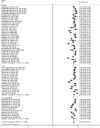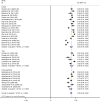Virological success after 12 and 24 months of antiretroviral therapy in sub-Saharan Africa: Comparing results of trials, cohorts and cross-sectional studies using a systematic review and meta-analysis
- PMID: 28426819
- PMCID: PMC5398519
- DOI: 10.1371/journal.pone.0174767
Virological success after 12 and 24 months of antiretroviral therapy in sub-Saharan Africa: Comparing results of trials, cohorts and cross-sectional studies using a systematic review and meta-analysis
Abstract
Background: UNAIDS recently defined the 90-90-90 target as a way to end the HIV epidemic. However, the proportion of virological success following antiretroviral therapy (ART) may not be as high as the anticipated 90%, and may in fact be highly heterogeneous. We aimed to describe the proportion of virological success in sub-Saharan Africa and to identify factors associated with the proportion of virological success.
Methods: We performed a systematic review and meta-analysis focusing on the proportion of patients in sub-Saharan Africa who demonstrate virological success at 12 and 24 months since ART initiation, as well as at 6 and 36 months, where possible. Programme factors associated with the proportion of virological success were identified using meta-regression. Analyses were conducted using both on-treatment (OT) and intention-to-treat (ITT) approaches.
Results: Eighty-five articles were included in the meta-analysis, corresponding to 125 independent study populations. Using an on-treatment approach, the proportions (95% confidence interval (CI)) of virological success at 12 (n = 64) and at 24 (n = 32) months since ART initiation were 87.7% (81.3-91.0) and 83.7% (79.8-87.6), respectively. Univariate analysis indicated that the proportion of virological success was not different by study design. Multivariate analysis at 24 months showed that the proportion of virological success was significantly larger in studies conducted in public sector sites than in other sites (p = 0.045). Using an ITT approach, the proportions (95% CI) of virological success at 12 (n = 50) and at 24 (n = 20) months were 65.4% (61.8-69.1) and 56.8% (51.3-62.4), respectively. At 12 months, multivariate analysis showed that the proportion of success was significantly lower in cohort studies than in trials (63.0% vs. 71.1%; p = 0.017). At 24 months, univariate analysis demonstrated that the proportion of success was also lower in cohorts.
Discussion: Regardless of the time following ART initiation, and of the threshold, proportions of virological success were highly variable. Evidence from this review suggests that the new international target of 90% of patients controlled is not yet being achieved, and that in order to improve the virological outcome, efforts should be made to improve retention in care.
Conflict of interest statement
Figures





References
-
- WHO. Fact sheet N°360. Available at http://www.who.int/mediacentre/factsheets/fs360/en/ (Last accessed on August 16 2016). 2015.
-
- UNAIDS. AIDS by the numbers 2015. Avaialble at: http://www.unaids.org/sites/default/files/media_asset/AIDS_by_the_number... last accessed August 16 2016. 2015.
-
- WHO. Global update on the Health sector response to HIV, 2014. Available at http://apps.who.int/iris/bitstream/10665/128494/1/9789241507585_eng.pdf (Last accessed on August 16 2016). 2014.
-
- WHO. Consolidated guidelines on the use of antiretroviral drugs for treating and preventing HIV infection Recommendations for a public health approach—Second edition. Available at http://www.who.int/hiv/pub/arv/arv-2016/en/ (Last accessed on August 17 2016). 2016. - PubMed
-
- WHO. Consolidated Guidelines on the use of antiretroviral drugs for treating and preventing HIV infection. Recommandation for a public Health Approch. June 2013. Available at http://apps.who.int/iris/bitstream/10665/85321/1/9789241505727_eng.pdf?ua=1 (Last accessed on August 17 2016). 2013.
Publication types
MeSH terms
Substances
LinkOut - more resources
Full Text Sources
Other Literature Sources
Medical

